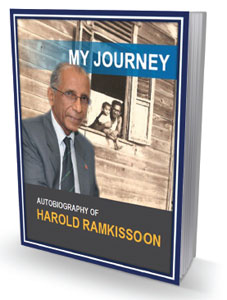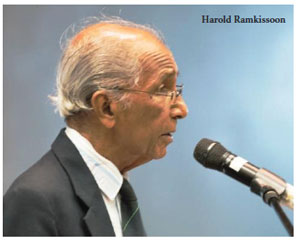|
June 2017

Issue Home >>
|

 I am interested in memoirs and autobiographies as a way of remembering and constructing history via life stories told by the person himself. In his foreword, Dr. Keith Mitchell says that Caribbean autobiographies are rare. This used to be true but is less so now—I think of the books by our Prime Minister, Dr Rowley, or by our former Vice-Chancellor Sir Alister McIntyre, or by the late business magnate Anthony Sabga, to cite just three recent examples. But autobiographies by scientists are certainly rare, in the region and perhaps everywhere. I’m always pleased to learn of new autobiographical publications, partly because they can be inspirational for readers, partly because they are valuable sources for studying the past (my profession). I am interested in memoirs and autobiographies as a way of remembering and constructing history via life stories told by the person himself. In his foreword, Dr. Keith Mitchell says that Caribbean autobiographies are rare. This used to be true but is less so now—I think of the books by our Prime Minister, Dr Rowley, or by our former Vice-Chancellor Sir Alister McIntyre, or by the late business magnate Anthony Sabga, to cite just three recent examples. But autobiographies by scientists are certainly rare, in the region and perhaps everywhere. I’m always pleased to learn of new autobiographical publications, partly because they can be inspirational for readers, partly because they are valuable sources for studying the past (my profession).
Harold is of Indian descent from a Hindu background, so his book adds to a rapidly growing literature of Indo-Trinidadian life stories published over the last few years, including autobiographies and memoirs, biographies, family histories and fiction (novels and short stories).
I was especially interested in Chapters 1 and 2, which deal with Harold’s growing-up years and his education. Harold’s struggle to get a secondary and university education against the odds is obviously a key theme here, but, with respect, this is NOT a “rags to riches” story. First, I’m not sure that Harold is exactly rich right now, and second, he didn’t come from “rags” ie from dire poverty (always related to the historical context).
Harold grew up in a rural Hindu family. His great-grandparents were indentured immigrants from India, so he is a third-generation Trinidadian. He was surrounded by his two extended families, and especially on his mother’s side, there were people who owned businesses and land, growing canes, cocoa and food crops. There’s no doubt that cash was very scarce as he grew up, and of course his childhood home lacked what we think of as basic amenities (electricity, piped water in the house), but that was standard in most rural houses in the 1940s and early ’50s.
The great advantage the young Harold enjoyed, besides his own intelligence and fierce determination, and his being the first son, was the support of his parents and the two big extended families, some of whose members were well-off by the standards of the day. But money was always scarce, and Harold was the first of 11 children. (As an aside, what a great example of the demographic transition and the shift in life patterns over one generation: Harold’s parents married at 19 and 17 and had 11 kids, Harold married at 35 and he and Tara had two.)
Harold grew up between Tabaquite, where he spent most of his childhood and where his mother came from, and Penal, his father’s home village. He paints a nice picture of the contrast between the two villages in the 1940s-50s. Penal was almost wholly Hindu, and nearly everyone followed the traditional rural life of Indo-Trinidadians in this period, as described so well by Morton Klass in his study of Felicity in the early 1950s. Tabaquite was a mixed community, with a significant “Spanish” element and a strong Roman Catholic tradition.
There was one other advantage that Harold had, though he may not have seen it at the time: like virtually all rural children growing up in this period, regardless of ethnicity, he worked on his relatives’ fields, doing various jobs, on weekends and school holidays. This kind of childhood nearly always instilled discipline and the values of hard work; Dr Rowley describes exactly the same thing about his childhood in rural Tobago a few years later.
Harold went to the Tabaquite RC primary school, because it was nearest home, and his teachers encouraged his precocious abilities. A caring headmaster of the old school coached the Exhibition Class, of which Harold was the brightest boy. And when the exam results came out, he came in at a mark of 197 (out of 200 possible awards) along with eight others. The government agreed to award 208 exhibitions that year because of this “tie” of nine children, and so Harold became the first Tabaquite child to win a free place to a secondary school. This was indeed his passport out of relative poverty.
Harold went to Presentation College, San Fernando—I assume he chose it over Naparima College because of the link with his Catholic primary school. For most of his time there he took the bus from Tabaquite, a journey of at least one and a half hours each way, leaving at 5 am. He used the time on the bus to study, yet another discipline-instilling practice which taught him time management and organization as a young boy.
Adjustment to college life wasn’t easy for the rural Hindu boy; here he was in the city, with many middle-class classmates from varying ethnic backgrounds, but few of them Hindus. As he puts it, it was the roti lunch, not eaten too openly, versus the sandwich lunch, a situation quite a few Indo-Trinis of his generation experienced.
He did well in his Higher School Cert exams (the equivalent of A-Levels) in 1960, but a health crisis prevented him from trying for an Island Scholarship. There would be no easy path to university for Harold; UCWI at St Augustine had just opened but didn’t offer an honours degree in Maths. He taught at Presentation College Chaguanas for three years, saved his money, and entered UWI Mona in 1963, with enough money to finance his first year in the BSc Maths programme.
 Harold was at Mona from 1963-66, and he greatly enjoyed the regional experience, with students from all over the Caribbean—something we have largely lost. It was Leslie Robinson, head of the maths department, who got the T&T Government to award Harold a scholarship for his second and third years. And it was Robinson who came to Taylor Hall at night to tell him personally he’d got a First, a true achievement back in the day, and helped him to gain a CIDA scholarship to do an MSc at the University of Toronto. Harold was at Mona from 1963-66, and he greatly enjoyed the regional experience, with students from all over the Caribbean—something we have largely lost. It was Leslie Robinson, head of the maths department, who got the T&T Government to award Harold a scholarship for his second and third years. And it was Robinson who came to Taylor Hall at night to tell him personally he’d got a First, a true achievement back in the day, and helped him to gain a CIDA scholarship to do an MSc at the University of Toronto.
That was the kind of personal, one on one interaction that many of us enjoyed at Mona in this period. “Mona spoiled us”, Harold writes; no wonder he felt the contrast at Toronto, a big city campus where you were left to your own devices and there was none of that personal caring (I remember feeling exactly the same thing when we went there to do our MA). But, as always, he persevered, and went on to study for his PhD in Fluid Dynamics at the Universities of Alberta and Calgary.
Harold began to teach in the Department of Maths here in 1976, and the rest, as they say, is history. He had a stellar academic career, becoming a Reader in 1990 and a Professor in 1998. He became an Ambassador for Caribbean science, helping to create and run several organizations which seek to raise the standard of science in the region, and to link our scientists to their international counterparts. You can read all about this, his travels and his many posts, and his memorable moments, in the rest of the book.
It’s a remarkable journey which certainly deserved to be written up and made available to all, and I congratulate Harold on making this effort; I hope it inspires many young people.
This is a version of the review presented by Professor Bridget Brereton at the launch of the autobiography on May 2, 2017.
|





